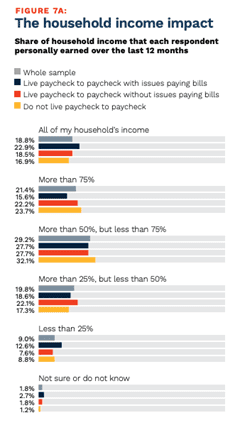23% of Single-Income Households More Likely to Struggle Paying Bills

When trying to manage the inflated prices of 2023, two paychecks are better than one.
It doesn’t take a deep knowledge of economics to grasp this, and while many households with two breadwinners still struggle to meet expenses, they tend to be better off than those living on a single income.
New Reality Check: Paycheck-To-Paycheck Report: 2022 Year In Review, a PYMNTS and LendingClub collaboration, explores the correlation between single and dual-income households and financial lifestyles, with nearly one-quarter (23%) of paycheck-to-paycheck consumers with issues paying their bills saying they are the sole breadwinner in their households.

“Struggling consumers are the most likely to say they are the only income provider in their household, potentially putting them in a particularly precarious position if they lose their job,” the study stated.
The report finds that 81% of households surveyed have more than one breadwinner. However, 40% of consumers in all financial lifestyles earn over 75% of their household’s income.
Taking a closer look at those breakdowns, 18.8% of respondents said they earn all household income, close to 30% (29.2%) are bringing in more than half of household income but less than 75%, and 19.8% are bringing in a quarter of funds, but still less than half of all household income.
Translated to financial lifestyles, 38.4% live paycheck to paycheck with issues paying bills, 40.7% live paycheck to paycheck without issues paying bills, and 40.6% don’t live between checks.
We found that among paycheck-to-paycheck consumers, “23% of those with issues paying their bills say they are the sole breadwinner in their household, notably more than the 19% of paycheck-to-paycheck consumers living without difficulty who earn all of their household income and the 17% of consumers not living paycheck to paycheck who identify themselves as the sole breadwinner.”
Looking at the breakdowns, male consumers and those earning $100,000 a year or above were more likely to be breadwinners, “carrying 75% or more of their household income. However, nearly one-third of female consumers said they carry 75% or more of their household income.”
The report shows that on average, 48.5% of males earned at least 75% of all household income, compared to 31.3% of females bringing in the largest share of household income.
Get the Report: New Reality Check: Paycheck-To-Paycheck Report: 2022 Year In Review
